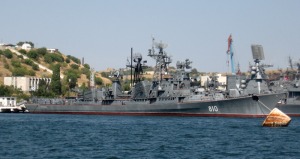Russia testing recognition of its annexation of Crimea
 On November 4th, Russia's delegation to the United Nations invited the International Atomic Energy Agency (IAEA) to inspect two nuclear facilities it controls within the Crimean Peninsula. These two nuclear reactors are small research and training reactors operated by the Sevastopol University of Nuclear Energy and Industry. Russia’s deputy representative to the UN, Alexander Pankin, stated that "Russia has taken full responsibility for nuclear sites in the country's new territorial entities.”
On November 4th, Russia's delegation to the United Nations invited the International Atomic Energy Agency (IAEA) to inspect two nuclear facilities it controls within the Crimean Peninsula. These two nuclear reactors are small research and training reactors operated by the Sevastopol University of Nuclear Energy and Industry. Russia’s deputy representative to the UN, Alexander Pankin, stated that "Russia has taken full responsibility for nuclear sites in the country's new territorial entities.”
At stake here is how the UN nuclear watchdog will act regarding a move that would imply tacit recognition of Russian control over the Crimean peninsula by an organization directly reporting to the UN. The resolution A/68/L.39 passed by the UN General Assembly on March 24, 2014, “calls upon all States, international organizations and specialized agencies not to recognize any alteration of the status of the Autonomous Republic of Crimea and the city of Sevastopol on the basis of the above-mentioned referendum and to refrain from any action or dealing that might be interpreted as recognizing any such altered status.” So far, the IAEA database of research reactors continues to list the Crimean reactors as being in Ukraine. This dilemma for the nuclear agency started as early as March 2014 when Russia asserted that its agreements covered the facilities located in Crimea. No comment has filtered from the agency in the past months. The agency is likely torn between the need to fulfill its mission of inspecting nuclear facilities and its desire to avoid recognizing Russia’s unilateral annexation, contrary to a handful of countries.
Unlike most countries, Afghanistan, Cuba, Syria, Venezuela, Nicaragua and the Pacific islands of Nauru have recognized Crimea as part of Russia. In addition, Russian allies such as Armenia, Afghanistan, Belarus, Kazakhstan, Kyrgyzstan, North Korea, Syria and Venezuela have all recognized the results of the referendum held on March 16, 2014 by the Autonomous Republic of Crimea and by the local government of Sevastopol which saw 96.77% of the voters wanting Crimea to join Russia. The breakaway republics of Abkhazia and South Ossetia in Georgia as well as the Armenian territory of Nagorno-Karabakh in Azerbaijan have also recognized the results of the referendum. More importantly, tacit recognition by China was achieved with a decision made during President Putin’s trip to Shanghai in May to invest $18.5 billion in Crimea.
Russia has advanced a number of precedents to justify the annexation of Crimea. First, it points to Kosovo whose independence has been recognized by the western powers, in particular to the 2010 ruling by the International Court of Justice according to which the unilateral declaration of independence by Kosovo without Serbia’s agreement complied with international law. However, Kosovo situation differs due to the ethnic cleansing which happened in the years prior, and the fact that independence took years to achieve. The Russian authorities also link Crimea to the retrocession of Saarland to Germany in 1936 or of Hong Kong to China in 1997. Yet, the “retrocession” of Crimea did not involve the Ukrainian authorities nor a formal treaty between the two states. Lastly, Russia has stressed that Crimea was part of Russia prior to 1954 much like Iraq justified the invasion of Kuwait in 1990 on the basis of the territory having been part of Iraq under the Ottoman rule. However, some note that the most relevant precedent, if any, is the Nazi invasion of the Sudetenland, a German-speaking territory of Czechoslovakia, in 1938 under the pretense of assisting German (here Russian) minorities under threat by the national government.
Beyond protecting Russian minorities abroad, the annexation of Crimea comes with its geoeconomic benefits. The Crimean peninsula provides Russia with additional access to the Black Sea for its military fleet and commercial tankers as well as more natural resources under its seabed. Indeed, the annexation significantly widens the Russian claim in the Black Sea adding approximately 36,000 square miles to Russia’s existing acreage, i.e. three times the actual size of Crimea. The maritime extension also includes fields such as Skifska estimated to hold from 7 to 9 trillion cubic feet of natural gas. Russia is already planning to build a gas pipeline to Crimea to meet the peninsula’s energy demand. Recognized or not, Russia is taking steps to integrate the newly acquired peninsula to its territory.
